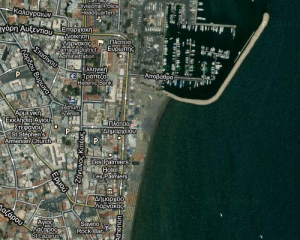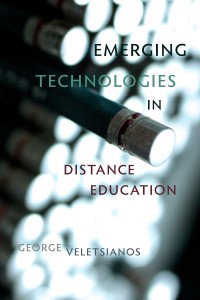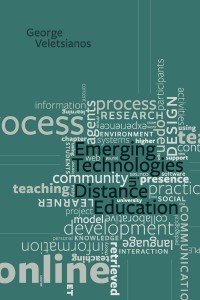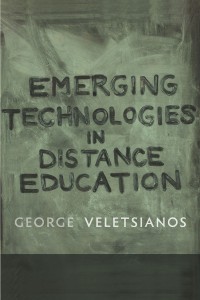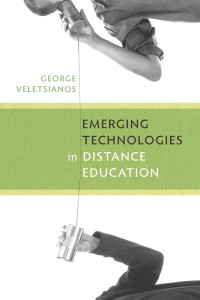The paper posted below is for an ITFORUM discussion I am leading on the topic of participatory scholars and participatory scholarship. Feedback is much appreciated!
Participatory Scholars and Scholarship
Dr. George Veletsianos
Instructional Technology
Curriculum and Instruction, College of Education
The University of Texas at Austin
ITFORUM Discussion paper: April 12-16, 2010
This paper is in very draft form.
Feedback is welcome (and greatly appreciated)
Participatory Scholars and Scholarship
Preface
Rarely do we post in-progress scholarship for public consumption. We usually hoard our research until journals are ready to publish it, at which time it magically becomes a “finished product,” despite the value of sharing, discussing, critiquing, and presenting our thoughts. In line with the ideas presented in this paper, and to demonstrate that sharing in-progress scholarship can be beneficial both for the field and the authors sharing their work, this paper is intentionally shared at an early phase of conceptualization. Some of the arguments and ideas presented below therefore are in need of further development. I expect that by the end of our discussion, I will have gained great new insights from you. I also hope that you will have gained much from this process, both to inform your future scholarship and your online presence and activity. Let the learning begin, and feel free to critique anything and everything!
Introduction
Educational technology research and practice has traditionally focused on instructors, trainers, learners, and learning environments, seeking to delineate the impact and implications of technological interventions on various outcomes such as learning and engagement. In this paper, I focus on scholars (e.g., doctoral students, professors, and researchers) and those supporting their roles (e.g., learning technologists) and their participation in online spaces. I argue that participation in online spaces (e.g., communities and networks of practice) is becoming increasingly important and absence from these spaces can be detrimental to scholarship, practice, and personal and professional development. For instance, participatory scholarship enables scholars to stay current in their research field, explore new approaches to teaching from their colleagues, engage with individuals mentioning their research/work, and expose their work to larger audiences.
While scholarship may traditionally be viewed as scientific discovery, its meaning in this paper is broader. Pellino, Blackburn, and Boberg (1984) for instance have expanded scholarship to include (a) professional activity, (b) research/publication, (c) artistic endeavors, (d) engagement with novel ideas, (e) community service, and (f) pedagogy. Further, Boyer (1990) proposed four functions of scholarship that reflect academic endeavors: scholarship of discovery, scholarship of integration, scholarship of application, and scholarship of teaching. In this paper, scholarship takes this broader meaning.
Networked & Participatory Scholarship
The term “participatory culture” describes a society in which the consumer is no longer a passive recipient of information, media, and artifacts, but also a producer of these. Jenkins et. al. (2006, pp. 7) describe a participatory culture as one
- 1. With relatively low barriers to artistic expression and civic engagement
- 2. With strong support for creating and sharing one’s creations with others
- 3. With some type of informal mentorship whereby what is known by the most experienced is passed along to novices
- 4. Where members believe that their contributions matter
- 5. Where members feel some degree of social connection with one another (at the least they care what other people think about what they have created).
The concept of participatory cultures has been embraced in educational circles, in which prior research has highlighted ideas similar to the ones proposed by Jenkins et. al. Notably, the description of participatory cultures proposed by Jenkins et. al. aligns with socio-constructivist (Kukla, 2000) and connectivistm (Siemens, 2006) points of view: In particular these two schools of thought imply that scholars practice scholarship within online social networks that serve to expand their learning, views, and activities relating to research and teaching practice. Situated within a community of practice, scholars’ work and activity becomes the mediating object which bounds together the network and community (Kaptelinin & Nardi, 2006). Specifically, Vygotsky (1978) highlights the importance of social interaction and negotiation of meaning in learning; Lave and Wenger (1991) discuss how learning transpires within communities of practice; Jonassen (2000) notes the value of active participation in learning; and McCombs and Whisler (1997) highlight the benefits of student-centered learning environments. In an era where social media participation is central in youth’s daily lives[1] (Lenhart, Madden, Macgill, & Smith, 2007), researchers have sought to understand (a) the practices and activities of youth in Social Networking Sites (Ellison, Steinfield & Lampe, 2008; boyd, 2008) and (b) the meaning of social media participation for 21st century education (Greenhow, Robelia & Hughes, 2009). While youth participation in social networking sites has seen extensive research interest in recent years, research on networked participation and the activities of scholars in online spaces is minimal. Specifically, while scholars have explored the affordances of social media for instructional and professional development purposes (e.g., Martindale & Wiley, 2005; Webb, 2009) writing in relation to the implications of the participatory culture for social scholarship beyond conceptual explorations is scant.
Lack of research however, does not mean that there is no interest in the topic. While higher education faculty may be more inclined to use “traditional” technologies than students (Roblyer, McDaniel, Webb, Herman, & Witty, in press), we have seen an increase in specialized social media tools targeting scholars. For example, Academia.edu (figure 1), Researchgate.net, and VIVO are three instances of online networking tools for researchers; TechLens is a research paper recommender system and Sciencefeed is a science-focused microblogging platform. In addition, web-based bibliographic tools, such as Zotero and Mendeley enable scholars to share their bibliographies and collaborate with others (figure 2), while social bookmarking sites enable the sharing of resources between scholars as well as between instructors and learners (Greenhow, Robelia & Hughes, 2009). For example, various web-based resources that were collected for the writing of this paper are available at http://www.delicious.com/veletsianos/scholar.
Figure 1. A publicly available profile on Academia.edu (http://oxford.academia.edu/RichardPrice)
Figure 2. A publicly available bibliography on Zotero.org (http://www.zotero.org/groups/web_2.0_in_education)
Indeed, it seems that scholarship is increasingly moving online and becoming more social and conversational in nature (Oblinger, 2010). The rise of the participatory web and scholar-focused web-based services provide enhanced opportunities for interaction, collaboration, and networking and renewed promise of breaking away from departmental and institutional silos (c.f. Hanson, 2009; Nixon, 1996). Yet, recent evidence from the British Library and the Researchers of Tomorrow project (2010) indicates that young researchers (doctoral students born between 1982 and 1994) are not utilizing social networking technologies for scholarship. Given the increasing empirical evidence suggesting that Net Generation students do not use technology in fundamentally different (or sophisticated) ways (Reeves & Oh, 2008; Nasah, DaCosta, Kinsell, & Seok, in press), one would expect that scholars born prior to 1982 are also not capitalizing on networked technologies for scholarship.
Scholars need to understand the affordances of networked technologies for social, participatory, and networked scholarship. Prior to discussing the important issues relating to 21st century scholar participation in online spaces, the following section presents trends influencing contemporary scholarship.
Trends influencing Digital Scholarship
A convergence of technological and social trends is promising to exert strong pressures on 21st century scholars and scholarship. In particular,
- Open Access (OA) publishing: OA publishing refers to the online publication of materials (especially journals and books) that are free-of-charge, and thus accessible to everyone. For example, Athabasca University Press is an OA publisher and Educational Technology & Society is an OA peer-review journal. This is not to say that OA publishing will replace traditional journals. For example, doubts about sustainability remain, especially as popular online journals close their doors (e.g., Innovate)
- Publication impact: On the one hand, online publishing allows authors and other interested parties to easily track the reach and impact of a publication (e.g., download counts). On the other hand, online publishing allows us to rethink peer-reviewed publications. For instance, the Public Library Of Science has started publishing a variety of metrics for each of their publications including article usage statistics (e.g., pageviews), comments/notes/ratings left by article readers, and blog posts citing published articles. These data help researchers gain a firm understanding of the impact of their publications, along with providing transparency to the research community (e.g., figure 3 shows the most read education articles/authors on Mendeley.com).
Figure 3. Most read articles and authors in Education (screenshot from Mendeley.com)
- Open Education: Open Education refers to open access to teaching/learning materials and institutions, and Wiley and Hilton (2009) argue that higher education must embrace openness to remain relevant in society. Examples of open education vary, ranging from individual faculty sharing their syllabi, to institutions sharing learning materials en masse online, to instructors opening up their online classrooms to learners who are not formally enrolled in a course.
- Tenure & Promotion (T&P): Research, teaching, and service are obviously valued in academia, but tenure and review policies are under pressure to change. For instance,
- T&P committees are accepting additional evidence for engagement with these three items (e.g., professional blogs as engagement with new ideas and scholarship of discovery)
- Additional items are being included in the list of valued contributions to the academy (e.g., software development)
- Scholars are utilizing the affordances of the web to support their T&P applications (and being open about the process in the course of doing so), and are able to provide multimodal evidence to support their applications (e.g., video). One example, is Dr. Couros’ application for tenure.
21st Century Scholars & Participatory Scholarship: Issues and Complexities
Even though recent technological advances have provided the impetus for scholars to productively participate in online networks of practice, the issues that arise as a result of participation in networked spaces are complex. Technical skills (such as setting up a blog or an RSS aggregator) are the least of scholars’ challenges. Participation in networked spaces for scholarship also requires a paradigmatic shift with respect to our identity as scholars and the purposes of education and scholarship. Below, I highlight a few of the issues related to participatory scholars and scholarship
- Participatory scholarship requires scholars to develop Personal Learning Networks (PLNs) and Personal Learning Environments (PLEs). PLEs “are the tools, artefacts, processes, and physical connections that allow learners to control and manage their learning” (Couros, 2010) while PLNs are the “the sum of all social capital and connections that result in the development and facilitation of a personal learning environment” (ibid). PLEs/PLNs were originally popularized for the generic learner but their appropriateness might shine in participatory scholarship and researcher training where self-directedness, lifelong learning, and personalization in learning, teaching and research is at the center of our work. Importantly, PLEs and PLNs as concepts rather than technological tools. While the information, knowledge, and connections harnessed within a PLEs/PLNs may be the result of tools (e.g., software aggregating relevant information), it is the idea of the individual being in charge of flexible and meaningful digital spaces that contain dynamically updated and personally-relevant information that is important. Similarly, while the PLN may be build, traversed, and mediated by contemporary social networking tools (e.g., Twitter), what is important is the notion of being able to access and share a persistent, co-created, and mutually beneficial space with other scholars. An example of a PLE is presented in figure 4. This image was taken from my RSS reader and shows a collection of items that I have marked as deeming further attention. In this image you will find articles that are in press and have just been posted online by the journals in which they were published (e.g., figure 5) and Blog posts from colleagues and students. Subscribing to RSS feeds for journals relevant to one’s field can be a daunting task, but this is where the value of openness, sharing, and networked participation in online spaces for scholarship is demonstrated: Dr. Doug Holton has created an extensive listing of RSS feeds for more than a hundred journals and has made it publicly available at http://edtechdev.wordpress.com/journals/
Figure 4. An RSS aggegator as a Personal Learning Environment
Figure 5. A PLE allows me near-instant access to published articles that interest me
- Participatory scholarship requires commitment (and takes time). Developing a PLN takes effort and commitment both in terms of cultivating relationships with colleagues and in terms of taking the time to understand participatory cultures. White (2008) uses the continuum of digital visitors and digital residents to understand participation in online spaces and this is helpful in understanding participatory scholarship as well. Digital residents would be those scholars who understand the affordances of the participatory web for scholarship, take the time to cultivate digital identities and relationships online, and view the web as a crucial component of their life. Digital visitors on the other hand would be those scholars who use the web as a tool when the need arises. In the context of digital scholarship for example, they would visit electronic databases (such as ERIC and Scopus) to update a literature review for a paper rather than have a PLE that keeps track of publications of interest. The difference is between information/resource delivery and information/resource searching. Yet, being a digital resident takes time because of the pressures that exist to remain relevant and visible. For instance, remaining visible on a social networking and fast-moving platform such as Twitter means that one has to share often and frequently. Otherwise, her voice and presence will be lost in the sea of tweets coming from others.
- Participatory scholarship requires the development of social and digital literacies and skills essential to the participatory web. Jenkins et. al. (2006) highlight the negative implications of the participation gap when youth do not have equal access to technologies. In the context of scholars, the participation gap refers to those scholars who participate in networked spaces and are able to take advantage of 21st century literacies to advance their career (e.g., learning new teaching approaches, promoting their research online, organizing colleagues to tackle important educational issues) vis-à-vis those who have had no exposure to participatory cultures or who do not have the essential literacies to engage in such activities online. Rheingold (2009 – http://blip.tv/file/2373937) is convinced that learners need literacies affording them to decode and encode the information in online spaces. These relate to attention, participation, collaboration, critical consumption, and network awareness (ibid). For example, the amount of relevant information available online is beyond our individual ability to attend to it, especially as we are bombarded with distracters that demand our attention (e.g., facebook messages from a long lost high school friend). Without access to these critical literacies, participatory scholars will not be effective participants in online spaces. Subscribing, following, and commenting to hundreds of scholars’ blogs for example will, at some point, become too much of a time commitment. Nevertheless, being a literate participatory scholar means figuring out ways to manage information overload. For instance, Steven Downes publishes a newsletter aggregating information relevant to online learning so that users don’t need to do it themselves. In essence, Downes acts as an information filter. Nevertheless, digital literacies also demand critical evaluation of the filter (any filter, and not just Downes) to ensure breadth of coverage. Deciding what or who to trust as a filter is perhaps as equally important as using a filter. Another example relating to digital literacies is the use of web services to alert scholars of information relating to their specific interests. For example, figure 6 shows an alert sent to me tracking the use of the term “pedagogical agents” in online spaces. This service allows me to keep ahead of developments in this research field, take note of newcomers to the field, and even take notice when instructors assign my papers as reading material for their courses (as long as they post their syllabus on a public site or assign blog reflections to their students).
Figure 6. Filtering personally-meaningful information
- Participatory scholarship requires scholars to cultivate online identities and monitor their digital footprints. Online identity refers to users’ presentation of themselves online (c.f. Coiro et. al. 2008) while digital footprints refers to the information available online about individuals (Madden et. al., 2007). Cultivating a scholarly online identity means refining online presence and reputation relating to one’s scholarship (e.g., topic of research) and taking an active role in managing that identity. For instance, participatory academics employ the services of text-mining techniques (e.g., Google Alerts) to track mentions of their name, publications, etc such that they can take an active role in managing how they are represented online. Note that in this context online presence is assumed to exist regardless of whether a scholar has taken any steps in cultivating such a presence: search for any scholar online and at the very least you will find a departmental or facebook profile. Rather than ignoring this presence, participatory scholars cultivate it, and take an active role in ensuring that their digital footprint accurately reflects their work. For example, figure 7 shows the results of a text-mining exercise on my last name.
Figure 7. Online identity management
- Participatory scholarship requires ongoing participation. Participation in online spaces is ongoing. Dormant social media profiles say as much about scholars as active participation in online spaces. Likewise, the process of scholarly inquiry does not end with publication. Papers are shared, discussed, and critiqued across social media, providing additional opportunities for feedback and review.
Concluding Thoughts
In this paper, I explored the meaning of participatory cultures for scholars, arguing that participation in online spaces is becoming increasingly important and absence from these spaces can be detrimental to scholarship and practice. This proposal has extensive implications for scholarship, academic institutions, tenure & review policies, and researcher training. The cultural shift required for this transition, while implicit in this discussion, is an important dimension in any discussion surrounding higher education and scholarship. While I hope that this paper resonated with you, I welcome critique, feedback, and discussion both through ITFORUM and through my blog where this paper is posted.
References
boyd, d. (2008). Facebook’s Privacy Trainwreck: Exposure, Invasion, and Social Convergence. Convergence, 14 (1).
Boyer, E. (1990). Scholarship reconsidered: Priorities for the professoriate. Princeton, NJ: The Carnegie Foundation for the Advancement of Teaching.
Coiro, J., Knobel, M., Lankshear, C., & Leu, D. (2008). Central issues in new literacies and new literacies research. In Coiro, J., Knobel, M., Lankshear, C., & Leu, D. (Eds.), Handbook of research on new literacies. (p. 1-21). New York: Lawrence Erlbaum.
Dunbar, R. (1998). Grooming, Gossip, and the Evolution of Language. Harvard University Press: Cambridge, MA.
Ellison, N., Steinfield, C., & Lampe , C. (2007) The Benefits of Facebook “Friends”: Social Capital and College Students’ Use of Online Social Network Sites. Journal of Computer-Mediated Communication, 12(4).
Greenhow, C. (2009). Social scholarship: Applying social networking technologies to research practices. Knowledge Quest, 37(4), 42-47.
Greenhow, C., Robelia, B., & Hughes, J. (2009). Learning, teaching, and scholarship in a digital age: Web 2.0 and classroom research: What path should we take now? Educational Researcher, 38(4), 233–245.
Pellino, G., Blackburn, R., & Boberg, A. (1984). The dimensions of academic scholarship: Faculty and administrator views. Research in Higher Education, 20, 103-115.
Kukla, A. (2000). Social Constructivism and the Philosophy of Science. New York: Routledge.
Jenkins, H., Clinton K., Purushotma, R., Robinson, A.J., & Weigel, M. (2006). Confronting the challenges of participatory culture: Media education for the 21st century. Chicago, IL: The MacArthur Foundation. Retrieved Feb. 20, 2010, from http://tinyurl.com/y8w4532
Jonassen, D. (2000). Computers as Mindtools for Schools: Engaging Critical Thinking. Columbus, OH: Prentice Hall.
Lave, J., & Wenger, E. (1991). Situated learning: Legitimate peripheral participation. Cambridge, UK: Cambridge University Press.
Lenhart, A., Madden, M., Macgill, A.R., & Smith A. (2007). Teens and social media: The use of social media gains a greater foothold in teen life as they embrace the conversational nature of interactive online media. Retrieved on March 3, 2010 from the Pew Internet & American Life Web site: http://www.pewinternet.org/PPF/r/230/report_display.asp
Madden, M., Fox, A., Smith A., & Vitak, J. (2007). Digital footprints: online identity management and search in the age of transparency. Retrieved on March 1, 2010 from the Pew Internet & American Life Web site: http://www.pewinternet.org/PPF/r/230/report_display.asp
Martindale, T., & Wiley, D. A. (2005). Using Weblogs in Scholarship and Teaching. TechTrends, 49(2), 55-61.
McCombs, B.L. & Whisler, J.S. (1997). The Learner-Centered Classroom and School. San Francisco: Jossey-Bass.
Nasah, A., DaCosta, B., Kinsell, C., & Seok, S. (in press). The digital literacy debate: an investigation of digital propensity and information and communication technology. Educational Technology Research and Development.
Oblinger, D.G. (2010). From the Campus to the Future. EDUCAUSE Review, 45(1), 42-52.
Reeves, T. C., & Oh, E. J. (2008). Generation differences and educational technology research. In J. M. Spector, M. D. Merrill, J. J. G. van Merrienboer & M. P. Driscoll (Eds.), Handbook of research on educational communications and technology (295-303). Mahwah, NJ: Lawrence Erlbaum.
Researchers of Tomorrow project (2010). Retrieved on February 14, 2010 from http://www.researchersoftomorrow.net/
Roblyer, M., McDaniel, M., Webb, M., Herman, J., & Witty, J. V. (n.d.). Findings on Facebook in Higher Education: A Comparison of College Faculty and Student Uses and Perceptions of Social Networking Sites. The Internet and Higher Education. Elsevier B.V. doi: 10.1016/j.iheduc.2010.03.002.
Siemens. G. (2006). Knowing knowledge. Retrieved on February 10, 2010 from http://www.knowingknowledge.com
Kaptelinin, V., & Nardi, B. (2006). Acting with technology: Activity theory and human computer interaction. Cambridge: MIT Press
Vygotsky, L. (1978). Mind in Society. London: Harvard University Press.
Webb, E. (2009). Engaging Students with Engaging Tools. EDUCAUSE Quarterly, 32(4), 1-7.
Wiley, D., & Hilton III, J. (2009). Openness, Dynamic Specialization, and the Disaggregated Future of Higher Education. The International Review Of Research In Open And Distance Learning, 10(5). Retrieved March 1, 2010, from http://www.irrodl.org/index.php/irrodl/article/view/768/1414
[1] At least in the United States

